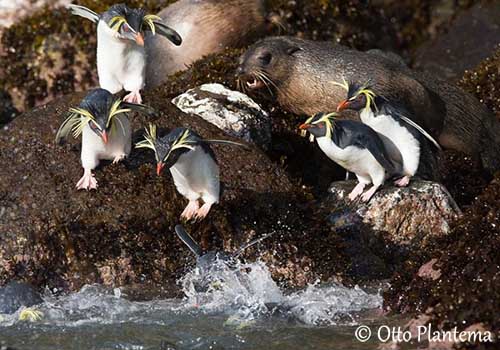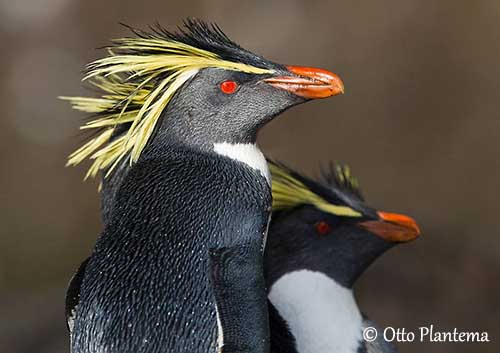
Fr: Gorfou de Moseley
All : Nördliche Felsenpinguin
Nd: Noordelijke Rotspinguïn
Photographer:
Otto Plantema
Trips around the world
Text by Nicole Bouglouan
Sources:
HANDBOOK OF THE BIRDS OF THE WORLD vol 1 by Josep del Hoyo-Andrew Elliot-Jordi Sargatal - Lynx Edicions - ISBN: 8487334105
BirdLife International (BirdLife International)
Penguins of the world (Mike Bingham)
PENGUINWORLD (Lloyd Spencer Davis)
PhotoVolcanica - Photography and Information by Dr Richard Roscoe
Welcome to the Penguin Project
Northern Rockhopper Penguin
Eudyptes moseleyi
Sphenisciforme Order – Spheniscidae Family
INTRODUCTION:
Formerly a subspecies of the Southern Rockhopper Penguin, the Northern Rockhopper Penguin is today considered a full species. Both species have similar appearance but the latter is larger and has longer and denser yellow crest. In addition, there are morphological, vocal and genetic differences too.
Classified as Endangered by BirdLife International, this species has suffered rapid decline of more than 50% in its usual range, with poorly known causes.
The islands where breeding colonies are established are reserves in order to manage and protect these populations.
DESCRIPTION OF THE BIRD:
Biometrics:
Length: 45-58 cm
Weight: 2500-3500 g
The adult has slate-grey upperparts and white underparts. The flippers are white on the underside, with partially black leading edge and tip. The size of each flipper is about 17-18 cm.
The head is slate-grey to black. We can see a black occipital crest, and elongated pale yellow feathers above the eyes.
The bill is brownish-red. The eyes are deep red. Legs and webbed feet are pink.

Both sexes are similar, although males are larger than females.
The juvenile has indistinct yellowish line above the eye, and short occipital crest. The chin is pale and mottled grey.
The chick has dark grey upperparts and white underparts. It has black bill with whitish tip and dark eyes. It is covered with thick down.
RANGE:
The Northern Rockhopper Penguin is found on S Atlantic islands on Tristan da Cunha and Gough islands, and there are other populations in S Indian Ocean on Amsterdam and St Paul islands.
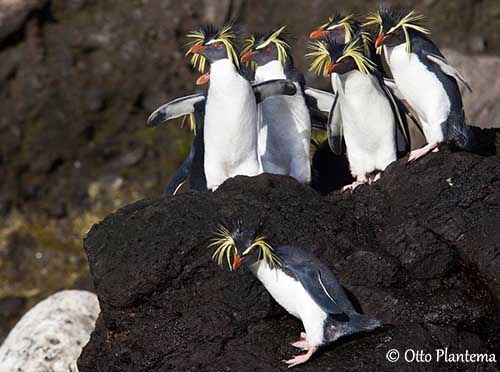
HABITAT:
The Northern Rockhopper Penguin breeds on rocky cliffs and in steep gullies, rocky shores and lava fields, sometimes with scattered grasses and shrubs. The nesting sites are often near freshwater natural pools or lagoons for drinking and bathing.
This species is marine and spends the winter months foraging at sea. Then, it returns to the shore for breeding in spring.
CALLS ANS SONGS: SOUNDS BY XENO-CANTO
The Northern Rockhopper Penguin is noisy, often aggressive and conspicuous. It produces raucous, braying sounds. We can also hear high-pitched squeaks interspersed with short pauses. Calls are usually shrill and unmelodious.
This species uses four types of calls such as contact call, mating call, alarm call and recognition with chicks.
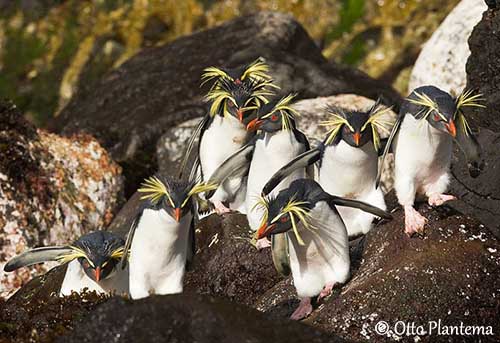
BEHAVIOUR IN THE WILD:
The Northern Rockhopper Penguin feeds on various species of crustaceans, squid and small fish. They are offshore feeders and often fish in groups. They are able to dive down to 100 metres depth. But crustaceans of genus Euphausia constitute their most frequent preys.
Preys are probably swallowed head first while the penguin in swimming underwater.
When they fish in groups, their movements are highly synchronized.
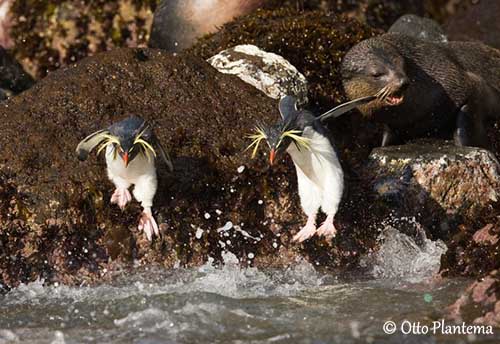
During the breeding season, the Northern Rockhopper Penguin is gregarious and breeds in large colonies. They are monogamous and the breeding pairs return to the same place every year.
Territorial and courtship displays are highly developed in dense colonies. Visual and vocal communications allow both mates and chicks to recognize each other.
Paired birds have long-term pair-bonds and usually pair for life. The male arrives first at colony and establishes the nest-site. The female returns about ten days later.
Some displays, and especially bowing, occur frequently. Another display involve head and beak pointing skywards with flippers well extended, while the penguin calls with the bill wide open and the head swinging from side to side. Both mates also perform mutual displays during which they bow or quiver in synchrony. Copulation takes place at nest. Then, both partners preen or rest.
The Northern Rockhopper Penguin has pre-nuptial moult in March. This period lasts 23-30 days and usually occurs on the breeding areas. The penguin spends these days on land until the new plumage is complete.
This species spends long periods at sea after moulting, before to return to its breeding site for the next breeding season. The location of these penguins at this period is currently unknown. They remain several months at sea.
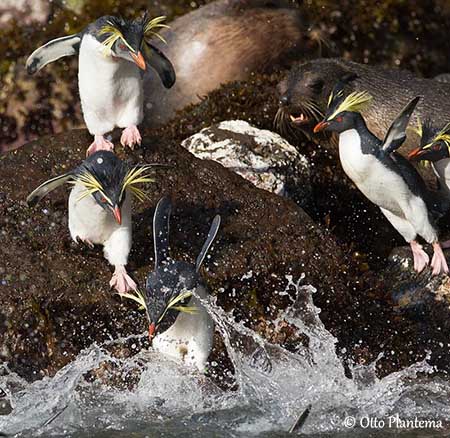
Like all the Spheniscidae species, this one swims and dives easily, propelled by the flippers, while webbed feet and tail are used for steering. When they are swimming underwater, penguins can be compared with birds flying in the air.
REPRODUCTION OF THIS SPECIES:
The laying occurs in early September and the eggs hatch by mid-October.
The Northern Rockhopper Penguin nests colonially, usually in rocky areas with some vegetation. The nest is made with stones, twigs and available materials in the surroundings. It is placed near or beneath a rock.
Several tracks lead from the colony to the coast, sometimes very steep, and penguins have to climb strongly.
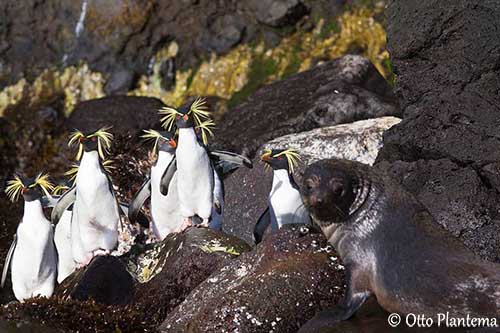
The female lays two whitish eggs over four days. Usually, only one chick is raised. The male departs on foraging trip after the laying, in order to gain body weight. When it returns, it incubates while the female goes at sea for feeding during two weeks.
She returns in time for hatching after one month of incubation. The male remains on the nest for brooding and guarding, whereas the female performs daily foraging trips to feed the chick.
Once the chick joins the crèche, at about 20 days of age, both parents return at sea and perform several trips every day during this period. The young fledges about ten weeks after hatching.
PROTECTION / THREATS / STATUS:
The Northern Rockhopper Penguin’s populations are threatened by natural predation, competition for food, increasing disturbance, oil pollution, introduced predators, reduced prey supplies due to overfishing and climate change.
Regular monitoring is undertaken on the main breeding islands which are reserves. But currently, the Northern Rockhopper Penguin is evaluated as Endangered.
